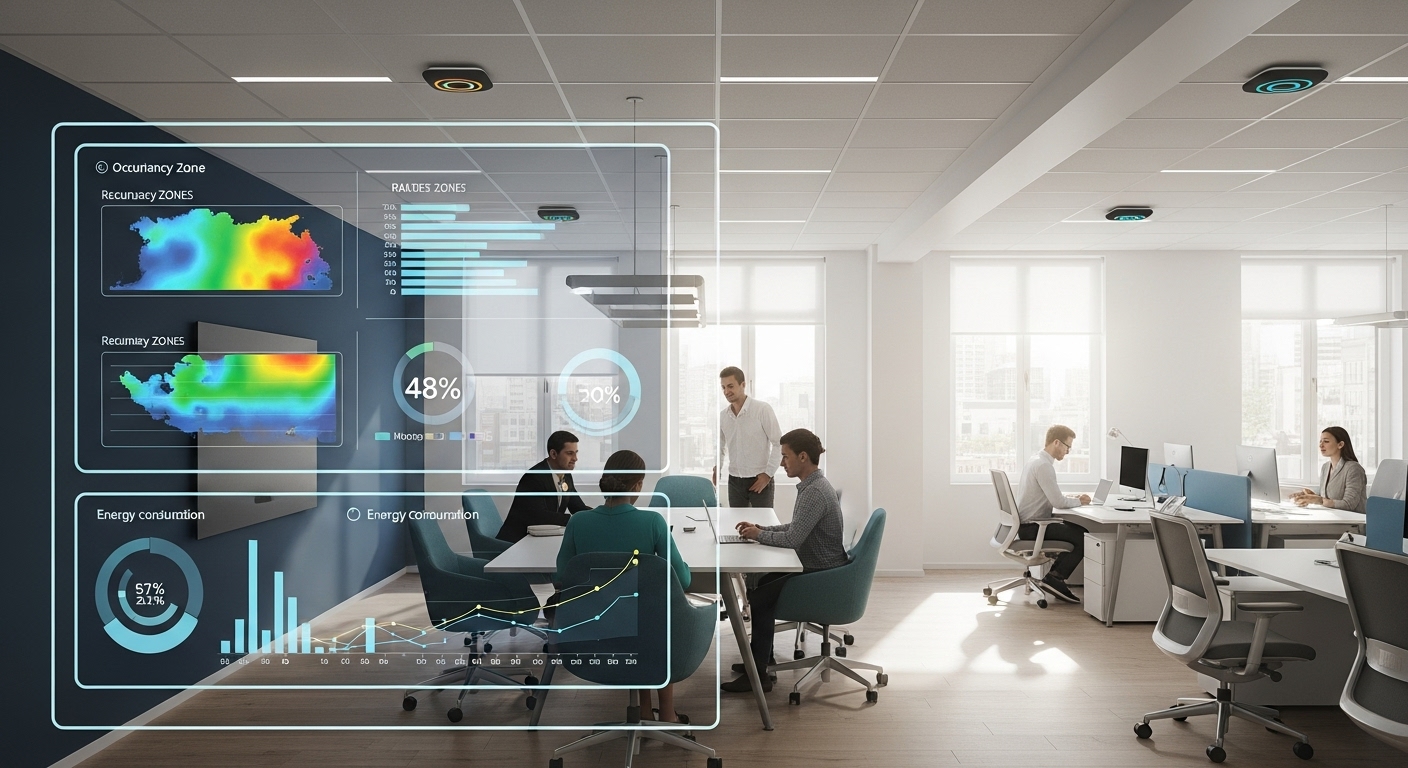The term ‘smart office’ often conjures images of voice-activated lights and automated coffee machines. While these conveniences are part of the picture, they represent just the surface of a much deeper technological shift. The true revolution lies not in the gadgets themselves, but in the vast streams of data they generate. Modern workplaces are becoming sentient ecosystems, equipped with sensors that monitor everything from space utilization and air quality to energy consumption. However, collecting this data is only the first step. The critical challenge for leaders is transforming this raw information into actionable insights and, ultimately, a measurable return on investment (ROI). Many organizations invest heavily in smart technology without a clear framework for capitalizing on the intelligence it provides. This article cuts through the noise to provide a strategic roadmap. We will explore how to connect disparate data points to core business key performance indicators (KPIs), moving from abstract metrics to tangible outcomes in real estate optimization, employee productivity, and operational efficiency.
Beyond the Buzz: Defining the Smart Office Data Ecosystem
To effectively leverage smart office technology, one must first understand the full scope of the data-generating ecosystem. It extends far beyond simple automation. At its core, this ecosystem is built upon a network of Internet of Things (IoT) devices. These include sophisticated occupancy sensors that go beyond motion detection to provide real-time headcounts for specific zones, desks, and meeting rooms. Environmental sensors are also critical, continuously monitoring factors like air quality (CO2, VOCs, particulate matter), temperature, humidity, and ambient light levels. This hardware forms the foundation, but the intelligence layer is powered by software, primarily Integrated Workplace Management Systems (IWMS). An IWMS acts as the central nervous system, aggregating data from various sources—including room booking platforms, access control systems, and the IoT sensors themselves—into a unified dashboard. This integration is what turns isolated data points into a holistic view of the workplace. The types of data generated can be broadly categorized into three buckets: spatial, environmental, and behavioral. Spatial data tells you how your physical space is being used. Environmental data provides insights into the health and comfort of the workspace. Behavioral data, derived from how people interact with the space and its systems, helps understand workflow patterns and collaboration trends. Understanding this complete ecosystem is the foundational step toward building a data-driven workplace strategy that yields concrete financial returns.
The Language of ROI: Connecting Data Points to Business KPIs
The true genius of a smart office lies in its ability to make the invisible visible, but this visibility is only valuable when linked directly to business outcomes. The key is to translate technology metrics into the language of the C-suite: Key Performance Indicators (KPIs) and Return on Investment (ROI). For instance, an occupancy sensor isn’t just measuring bodies in a room; it’s providing data to optimize your cost per square foot, a critical real estate KPI. If data reveals that 40% of assigned desks are unused on any given day, that translates directly into a quantifiable waste of expensive commercial real estate. By transitioning to a hot-desking model informed by this data, a company can reduce its physical footprint and slash lease costs. Similarly, environmental data has a direct, scientifically-backed impact on productivity. Studies have consistently shown that high CO2 levels, common in poorly ventilated meeting rooms, can impair cognitive function by as much as 50%.
A report from the Harvard T.H. Chan School of Public Health found that improving air quality can lead to productivity gains equivalent to thousands of dollars per employee per year.
By connecting air quality sensor data to employee productivity and reduced absenteeism, you build a powerful business case. Meeting room booking data can be linked to KPIs around collaboration efficiency. If data shows frequent overbooking of large rooms for small meetings, the solution—creating more huddle spaces—can be justified by the ROI of reclaimed employee time previously wasted searching for appropriate spaces.
Spatial Intelligence: Optimizing Your Real Estate Footprint with Data
Commercial real estate is often the second-largest expense for a company, making spatial optimization one of the most immediate and impactful sources of ROI from a smart office. In the age of hybrid work, understanding precisely how your office is used is no longer a luxury; it’s a necessity. Spatial intelligence, powered by occupancy sensors and workplace analytics platforms, provides the granular detail needed to make informed decisions. Instead of relying on anecdotal evidence or headcount forecasts, leaders can see real-time and historical heatmaps of their entire floorplan. This data uncovers critical patterns: which departments collaborate most frequently, which zones are consistently underutilized, and what the true peak occupancy load is. Imagine a company paying for five floors but data reveals that even on its busiest day, peak utilization never exceeds 65%. This insight is a direct call to action. The company could consolidate its operations onto four floors, subleasing the fifth to generate new revenue and dramatically reduce operational costs like utilities and maintenance. Data can also guide smarter layout designs. For example, if analytics show that teams are struggling to find quiet spaces for focused work, it provides a data-backed justification for converting an underused section of open-plan desks into focus pods or a designated quiet zone, directly addressing a pain point that impacts productivity.
The Human Factor: Leveraging Environmental Data for Peak Performance
While optimizing space delivers hard cost savings, optimizing the environment for people delivers significant ROI through productivity and well-being. A smart office’s environmental sensors act as a guardian for your most valuable asset: your talent. The link between physical environment and cognitive performance is well-documented. Smart lighting systems, for example, can implement circadian rhythm lighting, adjusting color temperature and intensity throughout the day to match natural light patterns. This has been shown to improve alertness and reduce eye strain, contributing to sustained focus. The most critical element, however, is often air quality. Sensors that continuously track CO2, volatile organic compounds (VOCs), and humidity allow the building’s HVAC system to respond proactively, not reactively. When a meeting room’s CO2 level begins to rise, the system can automatically increase fresh air circulation, preventing the cognitive decline and drowsiness that plague stuffy rooms. This investment translates into more effective meetings, better decision-making, and higher output. The ROI here is calculated not just in productivity gains, but also in talent retention and attraction. A workplace that demonstrably invests in the health and comfort of its employees becomes a powerful differentiator in a competitive job market, reducing turnover costs and attracting top performers who expect a superior work environment.
The Energy Equation: Slashing Operational Costs Through Intelligent Automation
Beyond real estate, energy consumption is a major operational expenditure where smart technology can deliver substantial and easily quantifiable ROI. Traditional office buildings are notoriously inefficient, heating, cooling, and illuminating empty rooms and entire floors after hours. An intelligent office eliminates this waste through data-driven automation. Occupancy sensors are the linchpin of this strategy. When a sensor detects that a meeting room, office zone, or the entire building is empty, it communicates with the Building Management System (BMS) to automatically set back the temperature and turn off all non-essential lighting. This simple action, repeated across thousands of square feet over a year, results in massive energy savings. According to the U.S. Department of Energy, commercial buildings can reduce energy costs by up to 30% by implementing smart automation and controls. The savings go further than just HVAC and lighting. Smart plugs can be connected to equipment like monitors and printers, automatically cutting power to them outside of working hours to eliminate ‘vampire load’—the standby power consumed by electronics when they are off. The data collected from these systems also provides facility managers with the insights needed to conduct predictive maintenance and identify faulty, energy-guzzling equipment before it fails, further reducing operational overhead and improving the building’s carbon footprint.
Navigating the Pitfalls: Data Privacy and Security in the Smart Office
Implementing a data-rich smart office strategy is not without its challenges, and overlooking the critical aspects of data privacy and cybersecurity can negate any potential ROI. Employees may understandably feel apprehensive about being ‘monitored.’ The key to navigating this is absolute transparency and a focus on collective benefit. It is crucial to communicate clearly what data is being collected (e.g., anonymous occupancy counts), how it is being used (e.g., to improve air quality and find available desks), and what is not being collected (e.g., individual tracking). The goal is to monitor the space, not the people. Anonymized, aggregated data is sufficient for nearly all spatial and environmental optimization goals. Creating a clear data governance policy and involving employees in the conversation can build the trust necessary for success. On the security front, every IoT sensor is a potential entry point for malicious actors. A comprehensive cybersecurity strategy is non-negotiable. This includes segmenting the IoT network from the core corporate network, ensuring all devices have strong, unique passwords, and implementing a regular patch management schedule. A single security breach could lead to significant financial loss, reputational damage, and legal liability, completely wiping out any savings or productivity gains achieved through the smart office initiatives. Therefore, a portion of the smart office budget must always be allocated to robust security measures from day one.
In conclusion, the journey from a traditional to a smart office is a strategic business initiative, not just a technological upgrade. The true value is unlocked when we shift our focus from the ‘smart’ devices to the ‘intelligent’ data they produce. By systematically connecting this data to core business objectives, organizations can realize a powerful and multifaceted return on investment. This ROI manifests in direct, tangible ways: through the significant reduction of real estate and energy costs by eliminating waste and inefficiency. It also delivers value through less tangible but equally impactful avenues, such as boosting employee productivity, creativity, and well-being by creating healthier and more responsive environments. The key is a holistic approach—one that begins with a clear understanding of the data ecosystem, establishes direct links to business KPIs, and is underpinned by a robust commitment to data privacy and security. The offices of the future will not be defined by their aesthetic or location alone, but by their ability to adapt, respond, and create value through the intelligent application of data. For leaders, the mandate is clear: move beyond the gadgets and start building a strategy around the data.





